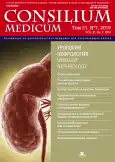Hybrid surgical pelvic diaphragm reconstruction: 3 years of follow up
- Authors: Shkarupa D.D.1, Kubin N.D.1, Petrov A.D.1, Shapovalova E.A.1
-
Affiliations:
- Pirogov Clinic of High Medical Technologies of Saint Petersburg State University
- Issue: Vol 21, No 7 (2019)
- Pages: 49-52
- Section: Articles
- URL: https://journals.rcsi.science/2075-1753/article/view/96816
- DOI: https://doi.org/10.26442/20751753.2019.7.190358
- ID: 96816
Cite item
Full Text
Abstract
Full Text
##article.viewOnOriginalSite##About the authors
Dmitrii D. Shkarupa
Pirogov Clinic of High Medical Technologies of Saint Petersburg State University
Email: hkarupa.dmitry@mail.ru
д-р мед. наук, врач-уролог, зам. дир. по организации медицинской помощи, главный уролог КВМТ им. Н.И. Пирогова Saint Petersburg, Russia
Nikita D. Kubin
Pirogov Clinic of High Medical Technologies of Saint Petersburg State Universityканд. мед. наук, врач-уролог урологического отд-ния КВМТ им. Н.И. Пирогова Saint Petersburg, Russia
Aleksandr D. Petrov
Pirogov Clinic of High Medical Technologies of Saint Petersburg State Universityordinator Saint Petersburg, Russia
Ekaterina A. Shapovalova
Pirogov Clinic of High Medical Technologies of Saint Petersburg State University
Email: katerina_andmed@mail.ru
obstetrician gynecologist Saint Petersburg, Russia
References
- Hendrix S.L, Clark A, Nygaard I et al. Pelvic organ prolapse in the Women’s Health Initiative: gravity and gravidity. Am J Obstet Gynecol 2002; 186: 1160-6.
- Brown J.S, Waetjen L.E, Subak L.L et al. Pelvic organ prolapse surgery in the United States, 1997. Am J Obstet Gynecol 2002; 186 (4): 712-6.
- Cetinkaya S.E, Dokmeci F, Dai O. Correlation of pelvic organ prolapse staging with lower urinary tract symptoms, sexual dysfunction, and quality of life. Int Urogynecol J 2013; 24 (10): 1645-50.
- Шкарупа Д.Д., Шаповалова Е.А., Кубин Н.Д. и др. Комбинированная реконструкция тазового дна при дефектах I и II уровней поддержки: задний интравагинальный слинг и субфасциальная кольпоррафия. Акушерство и гинекология. 2016; 8: 99-105. @@Shkarupa D.D., Shapovalova E.A., Kubin N.D. et al. Kombinirovannaia rekonstruktsiia tazovogo dna pri defektakh I i II urovnei podderzhki: zadnii intravaginal'nyi sling i subfastsial'naia kol'porrafiia. Akusherstvo i ginekologiia. 2016; 8: 99-105 (in Russian).]
- Hullfish K.L, Bovbjerg V.E, Gibson J, Steers W.D. Patient-centered goals for pelvic floor dysfunction surgery: what is success, and is it achieved? Am J Obstet Gynecol 2002; 187: 88-92.
- Bovbjerg V.E, Trowbridge E.R, Barber M.D et al. Patient-centered treatment goals for pelvic floor disorders: association with quality-of-life and patient satisfaction. Am J Obstet Gynecol 2009; 200: 568e1-e6.
- Шкарупа Д.Д., Пешков Н.О., Кубин Н.Д. и др. Русскоязычные версии опросников для оценки качества жизни больных с пролапсом тазовых органов и стрессовым недержанием мочи. Экспериментальная и клиническая урология. 2016; 1: 94-7.@@Shkarupa D.D., Peshkov N.O., Kubin N.D. et al. Russkoiazychnye versii oprosnikov dlia otsenki kachestva zhizni bol'nykh s prolapsom tazovykh organov i stressovym nederzhaniem mochi. Eksperimental'naia i klinicheskaia urologiia. 2016; 1: 94-7 (in Russian).]
- Ghoniem G, Hammett J. Female pelvic medicine and reconstructive surgery practice patterns: IUGA member survey. Int Urogynecol J 2015; 26 (10): 1489-94.
- Meriwether K.V, Antosh D.D, Olivera C.K et al. Uterine preservation vs hysterectomy in pelvic organ prolapse surgery: a systematic review with meta-analysis and clinical practice guidelines. Am J Obstet Gynecol 2018; 219 (2): 129-46.e2.
- Karram M.M, Sze E.H, Walters M.D. Surgical treatment of vaginal vault prolapse. In: Walters M.D, Karram M.M, editors. Urogynecology and reconstructive pelvic surgery. 2nd ed. St. Louis: Mosby, 1999; p. 235-56.
- Morgan D.M, Rogers M.A.M, Huebner M et al. Heterogeneity in Anatomic Outcome of Sacrospinous Ligament Fixation for Prolapse. Obstet & Gynecol 2007; 109 (6): 1424-33.
- Lukacz E.S, Warren L.K, Richter H.E et al. Quality of Life and Sexual Function 2 Years After Vaginal Surgery for Prolapse. Obstet Gynecol 2016; 127 (6): 1071-9.
- Rahkola-Soisalo P, Altman D, Falconer C et al. Quality of life after UpholdTM Vaginal Support System surgery for apical pelvic organ prolapse-A prospective multicenter study. Eur J Obstet Gynecol Reprod Biol 2017; 208: 86-90.
Supplementary files






